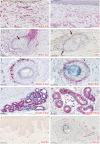Reconstitution of full-thickness skin by microcolumn grafting
- PMID: 27296503
- PMCID: PMC5697650
- DOI: 10.1002/term.2174
Reconstitution of full-thickness skin by microcolumn grafting
Abstract
In addition to providing a physical barrier, skin also serves a diverse range of physiological functions through different specialized resident cell types/structures, including melanocytes (pigmentation and protection against ultraviolet radiation), Langerhans cells (adaptive immunity), fibroblasts (maintaining extracellular matrix, paracrine regulation of keratinocytes), sweat glands (thermoregulation) and hair follicles (hair growth, sensation and a stem cell reservoir). Restoration of these functional elements has been a long-standing challenge in efforts to engineer skin tissue, while autologous skin grafting is limited by the scarcity of donor site skin and morbidity caused by skin harvesting. We demonstrate an alternative approach of harvesting and then implanting μm-scale, full-thickness columns of human skin tissue, which can be removed from a donor site with minimal morbidity and no scarring. Fresh human skin microcolumns were used to reconstitute skin in wounds on immunodeficient mice. The restored skin recapitulated many key features of normal human skin tissue, including epidermal architecture, diverse skin cell populations, adnexal structures and sweat production in response to cholinergic stimulation. These promising preclinical results suggest that harvesting and grafting of microcolumns may be useful for reconstituting fully functional skin in human wounds, without donor site morbidity. © 2016 The Authors Journal of Tissue Engineering and Regenerative Medicine Published by John Wiley & Sons Ltd.
Keywords: adnexa; full thickness; healing; regeneration; skin wound.
© 2016 The Authors Journal of Tissue Engineering and Regenerative Medicine Published by John Wiley & Sons Ltd.
Conflict of interest statement
Figures




Similar articles
-
Accelerated epithelialization and improved wound healing metrics in porcine full-thickness wounds transplanted with full-thickness skin micrografts.Wound Repair Regen. 2017 Sep;25(5):816-827. doi: 10.1111/wrr.12585. Epub 2017 Oct 11. Wound Repair Regen. 2017. PMID: 28922518
-
Wound Healing After Fractional Skin Harvesting.Dermatol Surg. 2022 Oct 1;48(10):1083-1088. doi: 10.1097/DSS.0000000000003552. Epub 2022 Aug 23. Dermatol Surg. 2022. PMID: 36036977 Clinical Trial.
-
Full-thickness skin wound healing using autologous keratinocytes and dermal fibroblasts with fibrin: bilayered versus single-layered substitute.Adv Skin Wound Care. 2014 Apr;27(4):171-80. doi: 10.1097/01.ASW.0000445199.26874.9d. Adv Skin Wound Care. 2014. PMID: 24637651
-
The increasing role of epidermal grafting utilizing a novel harvesting system in chronic wounds.Wounds. 2015 Feb;27(2):26-30. Wounds. 2015. PMID: 25785907 Review.
-
Tissue Engineered Skin and Wound Healing: Current Strategies and Future Directions.Curr Pharm Des. 2017;23(24):3455-3482. doi: 10.2174/1381612823666170526094606. Curr Pharm Des. 2017. PMID: 28552069 Review.
Cited by
-
Structural and molecular characteristics of weight-bearing volar skin can be reconstituted by micro skin tissue column grafting.FASEB J. 2024 Aug 15;38(15):e23873. doi: 10.1096/fj.202400866R. FASEB J. 2024. PMID: 39105468 Free PMC article.
-
The Antibiofilm Nanosystems for Improved Infection Inhibition of Microbes in Skin.Molecules. 2021 Oct 22;26(21):6392. doi: 10.3390/molecules26216392. Molecules. 2021. PMID: 34770799 Free PMC article. Review.
-
Application of a minimally invasive full-thickness autologous microcolumn skin harvesting device for donor site tissue collection and augmenting wound healing in a porcine wound model.Int Wound J. 2024 Dec;21(12):e70094. doi: 10.1111/iwj.70094. Int Wound J. 2024. PMID: 39681329 Free PMC article.
-
Apparatus for Harvesting Tissue Microcolumns.J Vis Exp. 2018 Oct 25;(140):58289. doi: 10.3791/58289. J Vis Exp. 2018. PMID: 30417866 Free PMC article.
-
Full-thickness Skin Micro-columns within a Dermal Matrix: A Novel Method for "Donor-free" Skin Replacement.Plast Reconstr Surg Glob Open. 2020 Dec 18;8(12):e3304. doi: 10.1097/GOX.0000000000003304. eCollection 2020 Dec. Plast Reconstr Surg Glob Open. 2020. PMID: 33425612 Free PMC article.
References
-
- Anderson RR, Donelan MB, Hivnor C, et al. 2014; Laser treatment of traumatic scars with an emphasis on ablative fractional laser resurfacing: consensus report. JAMA Dermatol 150: 187–193. - PubMed
-
- Beachkofsky TM, Henning JS, Hivnor CM. 2011; Induction of de novo hair regeneration in scars after fractionated carbon dioxide laser therapy in three patients. Dermatol Surg 37: 1365–1368. - PubMed
-
- Boggio P, Tiberio R, Gattoni M, et al. 2008, Is there an easier way to autograft skin in chronic leg ulcers? 'Minced micrografts', a new technique. J Eur Acad Dermatol Venereol 22: 1168–1172. - PubMed
-
- Bottcher‐Haberzeth S, Biedermann T, Klar AS, et al. 2014; Tissue engineering of skin: human tonsil‐derived mesenchymal cells can function as dermal fibroblasts. Pediatr Surg Int 30: 213–222. - PubMed
-
- Brusselaers N, Pirayesh A, Hoeksema H, et al. 2010; Skin replacement in burn wounds. J Trauma 68: 490–501. - PubMed
MeSH terms
LinkOut - more resources
Full Text Sources
Other Literature Sources

